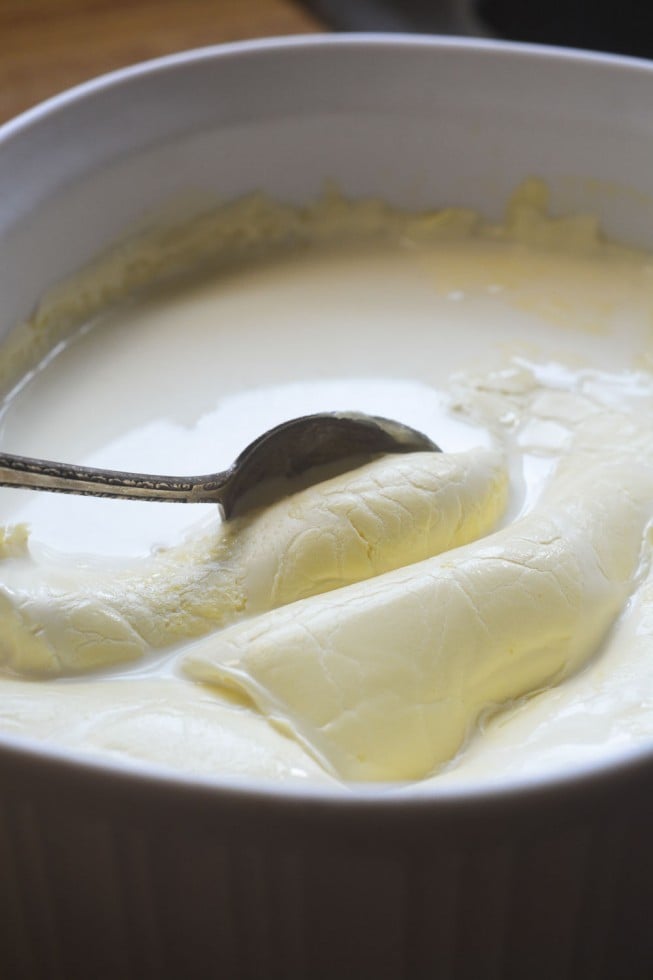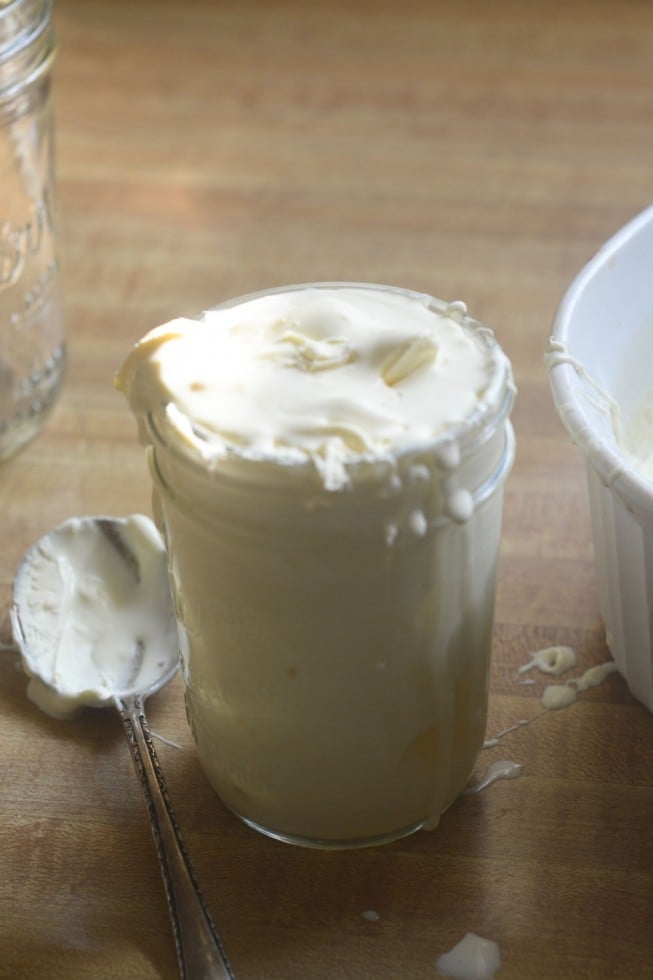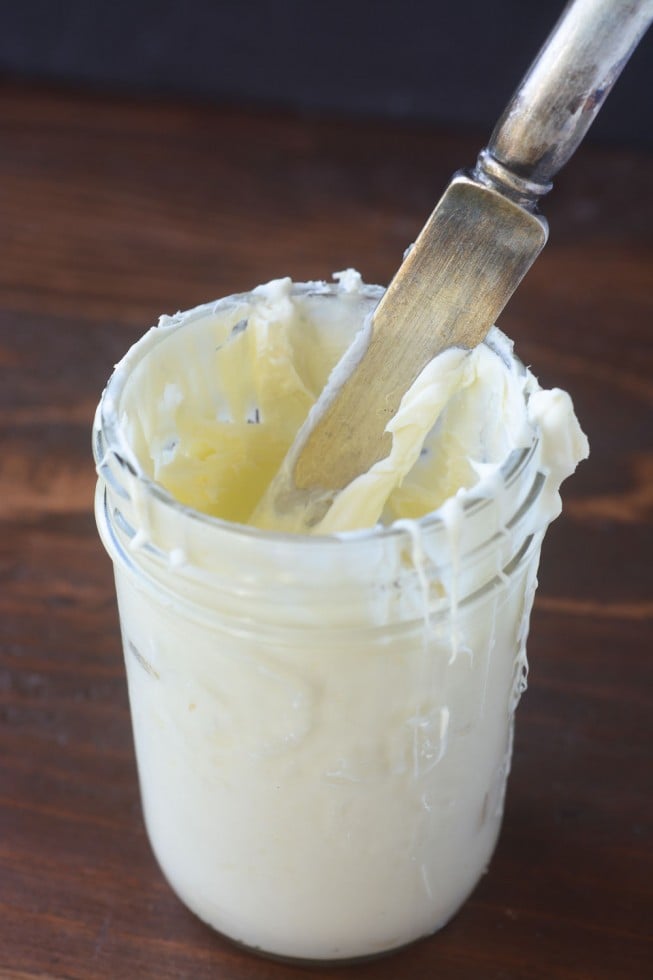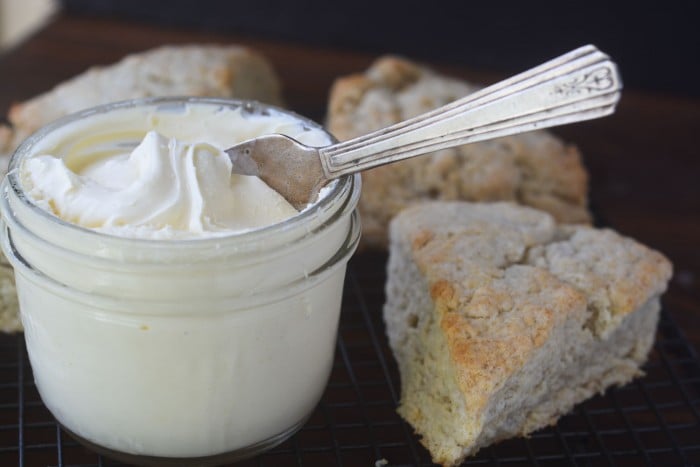“I have a British background and I have always had tea and something sweet. First time I tried this clotted cream I almost ate the entire jar by itself, it is that good!” ~Kim

If you’ve never had a classic English afternoon tea with scones and clotted cream, you’re missing out!
Last week I was treated by the historic Biltmore Hotel in downtown Los Angeles to their classic English afternoon tea. If you’ve never had a classic afternoon tea, you need to experience it. The highlight of any afternoon tea, besides the tea, is the array of tiny treats that comes with it, and I always zero right in on the scones and clotted cream. (That’s them on level two of our 3 tiered tea tray.)

What is Clotted cream?
If you’ve never had it, clotted cream is a very thick rich spreadable form of heavy cream that was first invented ages ago by some very smart British farmers. Traditionally cream heated until it thickens and develops a slightly nutty flavor. Clotted cream has a high fat content (around 55-65%) and a dense texture. It’s not like whipped cream, or cream cheese, it’s not like butter…it has a unique decadent consistency and a wonderful soft flavor. It’s quite thick and spreadable, and when you slather it on a freshly baked scone there is no better thing in the world.
The little pot of clotted cream that we got at the Biltmore had me craving more, and happily I made the most astounding discovery…you can actually make clotted cream at home in your own kitchen. No more tracking it down in specialty stores and paying big bucks for the imported stuff. My homemade clotted cream was actually way better (and a whole lot fresher) than the British stuff I usually buy.

What does clotted cream taste like?
Clotted cream has a rich, creamy taste with a slightly nutty ‘cooked’ flavor. It’s luxurious and indulgent, with a dense, velvety texture that is thicker and creamier than regular whipped cream. Clotted cream is also slightly sweet, but not as sweet as whipped cream or frosting, with a delicate flavor that pairs well with desserts, fruit, and scones. The crust on top of the clotted cream adds a slightly caramelized and nutty flavor, which many people find particularly delicious. The mouthfeel of clotted cream is a key part of its charm, and is like nothing else you’ve ever had!
what you’ll need
- heavy or whipping cream that has not been ultra-pasteurized
- This is cream that has been pasteurized, but not ultra-pasteurized. Ultra-pasteurized cream is cream that has been heated to a higher temperature than regular pasteurized cream to extend its shelf life.

How to make clotted cream
This is an amazing process, I hardly had to do anything, and I end up with a ton of the richest, silkiest clotted cream I’ve ever had.
- I used 2 pints of (non-ultra-pasteurized) heavy cream.
- I poured them into a baking dish, and left it overnight in a 180F oven (the lowest my oven will go.)
- In the morning I let it cool and then refrigerated it for the rest of the day.
- Then I scooped it into jars, which was a little sloppy at first, and put them back in the refrigerator. Any little bit of liquid gets absorbed right into the clotted cream after you put it in the jars, and by the next morning when I had it with my scones, it was absolutely to die for.

How long does clotted cream last?
Homemade clotted cream can last for up to 3-4 days when stored properly in the refrigerator. To extend its shelf life, it’s important to keep it in an airtight container and store it in the coldest part of the refrigerator, such as the back of the bottom shelf.
It’s important to note that clotted cream does not have any preservatives, so it should be consumed as soon as possible for the best flavor and texture. If you notice any changes in color, texture, or odor, discard the clotted cream immediately as it may have spoiled.

What to do with the leftover whey from making clotted cream
The leftover whey from making clotted cream can be used in a variety of ways:
- Adding it to smoothies or protein shakes for a boost of protein and nutrients.
- Using it as a substitute for milk or water in baking recipes such as bread, muffins, and pancakes.
- Using it as a marinade for meat or fish to tenderize and add flavor.
- Adding it to soups or stews for added richness and flavor.
- Using it as a liquid base for making homemade ricotta cheese or other soft cheeses.
- Feeding it to pets, as it is a good source of protein and nutrients for animals.
Note: It’s important to keep in mind that the leftover whey should be used or stored promptly to avoid spoilage. It can be stored in the refrigerator for up to a week or frozen for longer storage.

I can’t say enough good things about this project, the results far exceeded my expectations and it was absurdly easy. The only catch is that you can’t use ultra-pasteurized cream, which is cream that’s been processed for a longer shelf life. Many stores only sell ultra-pasteurized cream, so you have to search a bit for regular cream. I found mine at Whole Foods. Just read the labels… if it doesn’t say ultra-pasteurized on the label, you’re good to go.
can you make clotted cream with ultra-pasteurized cream?
Some readers in the comments below have had success with ultra-pasteurized cream. It is possible to make clotted cream from ultra-pasteurized cream, but it may be more difficult to achieve the desired texture and flavor. Ultra-pasteurization is a process that heats the cream to a higher temperature than regular pasteurization, which extends its shelf life but can also alter the proteins and enzymes in the cream. This can make it more difficult for the cream to form clots, which are necessary for making clotted cream.

What to eat with your homemade clotted cream
You will definitely want to make scones to go with your homemade clotted cream. I have lots of recipes for scones on the blog, but a simple one to start with is my Classic Cream Scones Recipe.

Tips for making clotted cream
- Make sure your cream is not ‘ultra pasteurized’, you will need to find regular pasteurized cream at a Whole Foods or other similar store. Ultra pasteurized cream has been treated in a way that prevents it from ‘clotting’.
- An oven thermometer is an essential kitchen tool, and really comes in handy for this project. If your oven is too cool or too hot your homemade clotted cream will not ‘clot’. Set your oven to 180F and then check the thermometer. You can adjust up or down as necessary.
- If your oven does not go down as low as 180F you can try one of my other methods for making clotted cream:

Homemade Clotted Cream
Video
Equipment
- a heavy casserole dish
Ingredients
- 2 pints heavy cream or whipping cream (double cream in the UK), avoid ultra-pasteurized cream for best results.
Instructions
- set your oven to 180F
- Pour the cream into the casserole dish. It should come up about 1-3 inches on the side.
- Set the dish, uncovered, in the oven and leave undisturbed for 12 hours. Be sure to leave the oven on the whole time. I do this overnight.
- Remove the dish from the oven and set to cool. Then cover and refrigerate. Note: the cream may seem thin at this point, but is going to thicken considerably overnight.
- The next morning scoop the thickened cream into a jar or jars, and cover and put back in the refrigerator. You can use the leftover cream for baking..
- Spread the clotted cream on freshly baked scones.
Nutrition























I do not have an instant pot and do not know if my oven will go down to 180. Can clotted creme be made in a slow cooker.
I haven’t had success in a slow cooker, but you can make it on the stove top, see my post here. It’s quite easy!
OMG!! Made this over the weekend & it’s everything I wanted it to be! Had to travel 60min. to get descent scone & clotted cream but they only gave us a tiny little bit. Now I can indulge to my heart’s content. Thank you, thank you, thank you!
I tried to make this recipe with ultra-pasteurized cream, overnight, but the oven was off when I got up this morning. I had put the pot of cream in a bain marie though, which seems to have kept it hot enough to work, as it had the crusty yellow top I’ve heard about.
I watched an episode about the Ritz in London and they showed the tearoom. I was fascinated and made it in my Instant Pot yesterday. It’s really super easy and delicious. My granddaughters and I will be having a tea party this afternoon. I will make this again.
Thank you,
How did you do it in the ip?
Just look up my post, Brandi, for the details, here.
I haven’t had clotted cream since the early 80’s and this brings back a flood of beautiful memories. Very easy recipe that came out perfectly the first time. I’ve been saving my Oui yogurt jars and now have the perfect way to store the clotted cream. Trader Joe’s has the required heavy cream and at a great price. I’m going to use Press n Seal for the tops as I’ll be giving them as gifts with my scones. Thank you so much for this recipe!
So glad it worked out so well for you Stephanie, I love the idea of giving it with scones ~ happy 2021!
Hi! I am wanting to have clotted cream for Christmas morning with scones and was excited to find this recipe!! I have an instant pot and embarked on this process but as soon as I pressed the yogurt button, i realized mine didn’t say “boil” or have that as an option. I must have an older model, it starts immediately with an eight hour timer and then I can go up or down on time, that’s it. I’m not sure what to do? Just put it on yogurt for eight hours?
Sue, is it possible to leave the cream chilling for too long?
I don’t think so.
I’ve made this twice now, first time I used Raw Jersey Cow cream, and there was a ton of liquid, a small amount of clotted cream, the skin was dark-ish and the cream underneath quite wet. But it was still delicious and so indulgent. This last time I used pasteurized organic heavy cream that was so luxuriously thick, to begin with, and it came out with a light crust but almost the entire 3 pints clotted and I had 1 cup of whey left. The texture was heavy and thick like cream cheese. Very delicious!
I absolutely love your clotted cream recipe. I have made it for a friend of mine, who is from England, and she loves it and says it is perfect. I do use the ultra pasteurized cream now though. I have also used the non ultra pasteurized cream. It’s the same each way! We love it!
Hi, I followed this to the letter but… it came out tasting, well, like bad milk, rancid or something. I don’t know what I did wrong?!
Hmmmm, could have been the cream, are you sure it was fresh? That’s all I can think of. The flavor is supposed to taste slightly ‘cooked’, but definitely not spoiled.
Ty for the reply! OK! I’m up for trying again! Will it have any sweetness? My neighbor is from Britain and talks about Victoria cake and how much she misses it- I want to try to pull off a surprise, if i can get this cream right that is.
No, clotted cream is not sweet in any way, except for the faint natural sweetness of the cream. Victoria sponge cake is made with whipped cream, and I have a recipe for it here: https://theviewfromgreatisland.com/classic-victoria-sponge-cake-recipe/